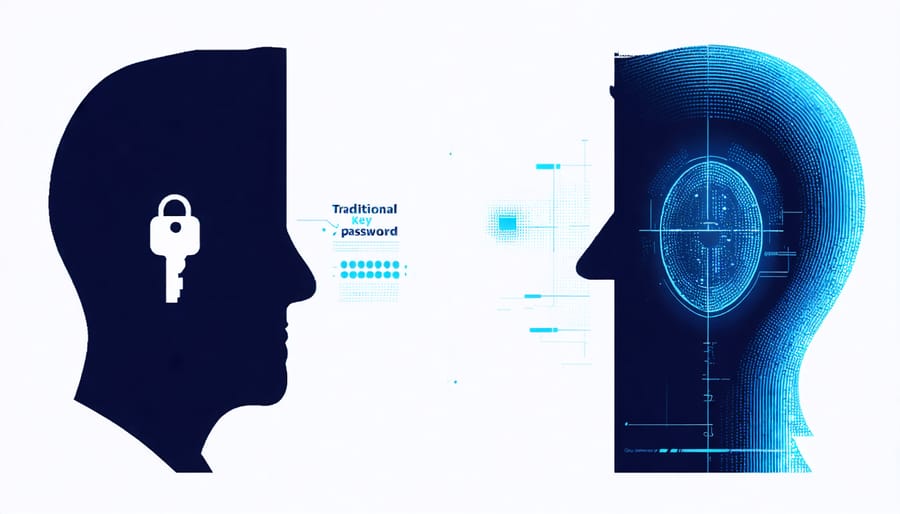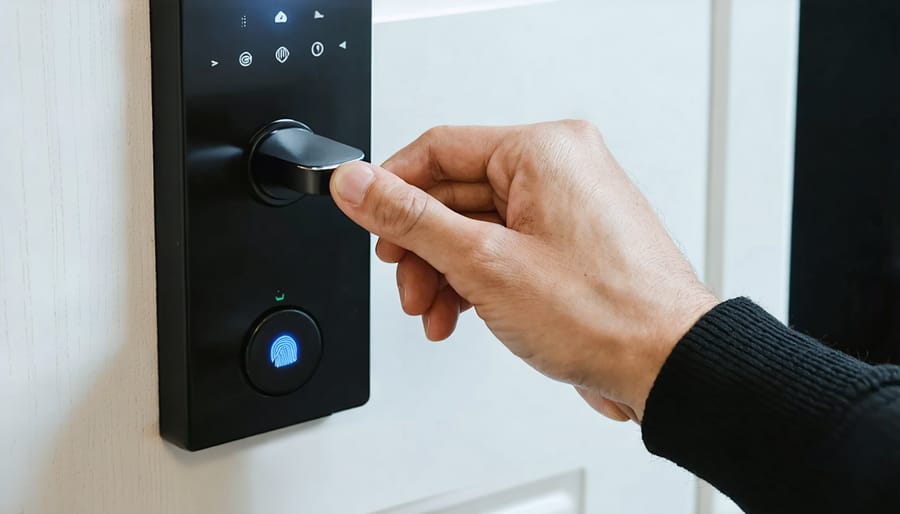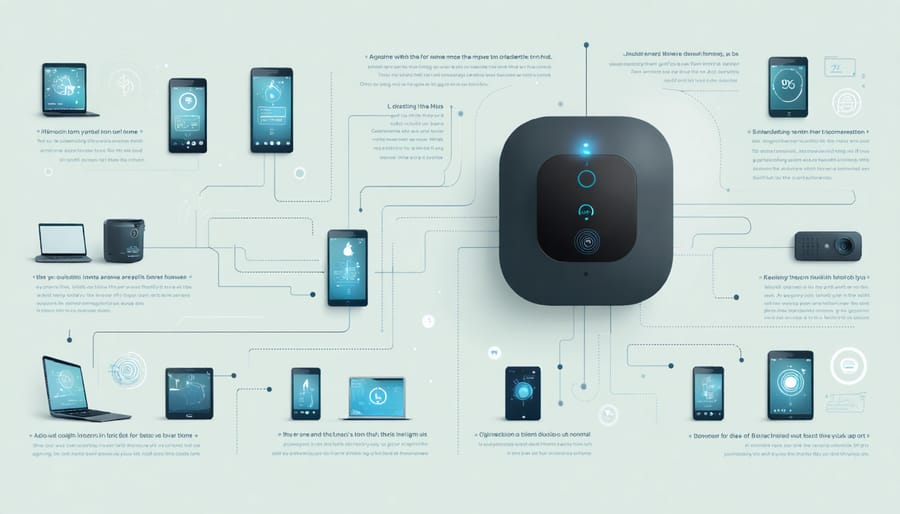Unlock your home’s security potential with biometric authentication – the same technology protecting government facilities and Fortune 500 companies. Modern AI-powered home security systems now integrate fingerprint scanning, facial recognition, and voice authentication to create an impenetrable yet convenient security shield around your property.
Gone are the days of lost keys and forgotten security codes. Your unique biological markers – impossible to replicate or steal – become your password, offering military-grade protection while streamlining your daily routine. These sophisticated systems analyze over 100 unique points on your fingerprint or face in milliseconds, automatically adjusting to subtle changes as you age while maintaining ironclad security.
For homeowners seeking the perfect balance between cutting-edge protection and user-friendly operation, biometric security represents the golden standard in modern home protection. Whether you’re securing a single entrance or implementing a comprehensive home security solution, these systems offer unparalleled peace of mind through technology that’s both remarkably sophisticated and surprisingly simple to use.
How Biometric Security Makes Your Home Safer
Beyond Traditional Keys and Passwords
Remember those days of juggling multiple keys or trying to remember complex passwords? While traditional security methods have served us well, they come with their fair share of headaches. Keys can be lost, copied, or stolen, and passwords can be forgotten or compromised. Plus, there’s always the risk of sharing them with the wrong person.
Biometric security systems offer a refreshing alternative by using what’s uniquely yours – your physical characteristics. Unlike keys that can be duplicated or passwords that can be guessed, your fingerprints, facial features, and iris patterns are exclusively yours. This makes biometric systems inherently more secure and convenient.
Think about it: you can’t forget your fingerprint at home, and it’s practically impossible for someone to steal your iris pattern. Biometric systems also eliminate the need to remember multiple passwords or carry around a keychain. They provide instant access while maintaining robust security, making them particularly appealing for busy households where family members come and go throughout the day.
The best part? Many biometric systems can be integrated with your existing smart home setup, offering seamless automation and enhanced security in one package.

The Science Behind Biometric Recognition
Biometric recognition works by measuring and analyzing unique physical or behavioral characteristics that make you, well, you! Think of it as your body’s own special signature. These systems use advanced sensors and cameras to capture specific features like your fingerprint ridges, the unique pattern of your iris, or the geometry of your face.
When you first set up a biometric system, it creates a digital template of your characteristics, converting them into a secure code that’s stored in the system. This template isn’t actually a picture of your fingerprint or face – it’s more like a mathematical representation of your unique features.
Each time you try to gain access, the system scans your biometric data and compares it to the stored template. It’s looking for a match, kind of like fitting a key into a lock. The whole process happens in seconds, making it both secure and convenient.
What’s really clever is that these systems use advanced algorithms to adapt to slight changes. For example, a fingerprint reader can still recognize your print even if you have a small cut or if your finger is slightly dirty.
Popular Biometric Security Features for Your Home
Fingerprint Recognition Doors and Locks
Fingerprint recognition technology has become increasingly popular for home security, offering a perfect blend of convenience and robust protection. Installing a fingerprint door lock is surprisingly straightforward – most models come with detailed instructions and require only basic DIY skills and common tools like a screwdriver and drill.
The benefits of fingerprint recognition doors are compelling. They eliminate the need for keys (which can be lost or copied), allow you to grant temporary access to guests or service providers, and maintain a log of who enters your home and when. Many modern systems can store up to 100 different fingerprints and integrate seamlessly with your smart home setup.
When choosing a fingerprint lock, we recommend considering weather resistance, battery life, and backup entry methods. The Samsung SHS-P718 offers excellent reliability and smart home integration, while the Ultraloq U-Bolt Pro combines fingerprint recognition with multiple entry options. For budget-conscious homeowners, the AIGURD Fingerprint Door Lock provides great value without compromising on essential features.
Pro tip: Install your fingerprint lock in a location protected from direct rain and extreme temperatures to ensure optimal performance. Also, register multiple fingers for each user – this provides a backup if one finger is injured or dirty. Remember to clean the scanner periodically with a microfiber cloth to maintain accuracy.

Facial Recognition Security Cameras
Facial recognition security cameras have revolutionized home security by combining advanced AI technology with traditional surveillance systems. These smart cameras use sophisticated algorithms to identify and verify individuals by analyzing unique facial features, such as the distance between eyes, nose shape, and jawline.
When someone approaches your door or enters a monitored area, the camera captures their image and compares it against a database of approved faces you’ve previously stored. This happens in real-time, allowing the system to quickly determine if the person is authorized to enter or if they’re a potential security threat.
Integration with smart home systems takes this technology to the next level. You can receive instant notifications on your smartphone when familiar faces are detected, like family members arriving home from school or work. The system can also trigger automated responses – turning on lights when recognized residents arrive home, or sending alerts when unknown individuals are spotted.
Many modern facial recognition cameras offer additional features like night vision, two-way audio communication, and the ability to create time-based access schedules. For example, you might allow your house cleaner access only during specific hours on certain days.
To ensure privacy, these systems typically include advanced encryption and secure storage of facial data. You maintain complete control over whose faces are stored in the database and can easily update permissions as needed. Remember to position cameras strategically at entry points while respecting neighbors’ privacy and local regulations.
Voice Recognition Systems
Voice recognition technology has become an increasingly popular choice for home security, offering a hands-free and highly personalized way to protect your space. Just like your unique fingerprint, your voice has distinct characteristics that make it virtually impossible to replicate, making it an excellent security feature.
These systems work by analyzing various aspects of your voice, including pitch, tone, and speech patterns. When you speak your designated passphrase or command, the system compares it to your stored voiceprint to grant or deny access. Many modern voice recognition systems also incorporate anti-spoofing features that can detect recorded voices, adding an extra layer of security.
One of the biggest advantages of voice recognition is its convenience. Imagine unlocking your front door while carrying groceries or disarming your security system without fumbling for a keypad. Plus, you can create different voice commands for different family members, making it easy to track who’s accessing what and when.
For best results, set up your voice recognition system in a quiet environment and create distinct, memorable passphrases. It’s also smart to periodically update your voice prints and choose a system that allows for backup access methods, just in case you lose your voice to a cold or laryngitis.
Remember that while voice recognition is convenient, it works best as part of a comprehensive security strategy rather than a standalone solution.
Installation and Integration Tips
DIY vs Professional Installation
When it comes to installing biometric security systems, you have two main options: tackling it yourself or hiring a professional. While DIY security installation can save money, it’s important to assess your comfort level with technology and the complexity of your chosen system.
Basic biometric systems, like standalone fingerprint door locks or simple facial recognition cameras, are generally suitable for DIY installation. These typically come with user-friendly instructions and mounting hardware, costing around $200-500 for the equipment. You’ll mainly need basic tools and 2-4 hours of your time.
Professional installation, while pricier, offers several advantages. Experts ensure proper placement, configuration, and integration with existing security systems. They can also provide valuable guidance on optimal positioning and usage. Professional installation typically costs $300-800 on top of equipment costs, depending on system complexity and your location.
Consider these factors when deciding:
– Technical expertise required
– System complexity and integration needs
– Time investment
– Warranty implications
– Local building codes and regulations
For simple, standalone units, DIY can be a cost-effective choice. However, for whole-house systems or those requiring integration with other smart home features, professional installation often proves worthwhile, ensuring proper functionality and peace of mind.
Connecting with Your Smart Home Hub
Integrating your biometric security system with existing smart home systems is easier than you might think. Most modern biometric devices are designed to work seamlessly with popular home automation hubs like Amazon Alexa, Google Home, or Apple HomeKit.
Start by ensuring your biometric device and hub are connected to the same Wi-Fi network. Download your hub’s companion app and look for the “Add Device” or “Connect New Device” option. Select your biometric security device from the list of compatible devices, and follow the on-screen prompts to complete the pairing process.
Once connected, you can create custom automation routines. For example, when your fingerprint is scanned at the front door, you can program your lights to turn on, adjust the thermostat, and disarm your security system. Many hubs also allow you to group multiple biometric devices together, creating a comprehensive security network throughout your home.
Remember to regularly update both your hub and biometric device’s firmware to ensure optimal performance and security. You can manage all your connected devices through your hub’s dashboard, making it simple to monitor activity, adjust settings, and receive notifications when someone enters or exits your home.
Pro tip: Keep a backup access method, like a PIN code, in case your hub experiences connectivity issues.

Privacy and Security Considerations
When it comes to biometric security systems, privacy and data protection are understandably top concerns for many homeowners. After all, your biometric data is uniquely personal and irreplaceable – you can’t simply change your fingerprints like you would a password.
The good news is that modern biometric security systems are designed with robust protection measures. Most quality systems encrypt your biometric data using advanced algorithms, storing only encrypted templates rather than actual images of your fingerprints or facial features. This means that even if someone were to gain unauthorized access to the system, they couldn’t reconstruct your actual biometric information.
To ensure your biometric data stays secure, consider these important factors:
1. Local vs. Cloud Storage: Many systems offer local storage options, keeping your data entirely within your home rather than on external servers. This reduces the risk of data breaches through internet connectivity.
2. Encryption Standards: Look for systems that use industry-standard encryption protocols to protect stored data. AES-256 encryption is currently considered one of the most secure options.
3. Regular Updates: Choose a system from a reputable manufacturer that provides regular security updates and patches to address new vulnerabilities.
4. Access Control: Implement strong administrator passwords and limit who can add or remove biometric data from the system.
It’s also worth noting that quality biometric systems include anti-spoofing technology to prevent unauthorized access through photographs or artificial replicas. Many use “liveness detection” to ensure they’re scanning an actual person rather than a photo or recording.
Remember to read the privacy policy of your chosen system carefully and understand how your data will be collected, stored, and used. Some manufacturers may collect anonymous usage data for system improvements, but you should have the option to opt out of such programs.
By choosing a reputable system and following proper security protocols, you can enjoy the convenience of biometric security while keeping your personal data safe and private.
As we’ve explored throughout this article, biometric security systems represent a significant leap forward in home protection, offering a perfect blend of convenience and cutting-edge security. These systems have transformed from a luxury into an increasingly accessible option for everyday homeowners, providing peace of mind through unique biological identifiers that can’t be easily duplicated or stolen.
The future of home security looks even more promising, with emerging technologies like multi-factor biometric authentication and artificial intelligence integration on the horizon. We’re seeing rapid developments in facial recognition accuracy, more affordable fingerprint sensors, and even voice recognition systems that can distinguish between live speakers and recordings.
For homeowners considering an upgrade to their security system, the benefits are clear: no more lost keys, improved access control, detailed activity logs, and significantly enhanced security. While the initial investment might be higher than traditional security systems, the long-term value in terms of security and convenience makes it a worthwhile consideration for any modern home.
As these systems become more mainstream, we can expect to see even more innovative features, lower prices, and easier installation options. Whether you’re tech-savvy or just starting to explore smart home solutions, biometric security systems offer a future-proof way to protect what matters most – your home and family.
Remember to carefully evaluate your specific needs, budget, and privacy preferences when choosing a biometric security system, and consider working with a professional installer to ensure optimal performance and security.